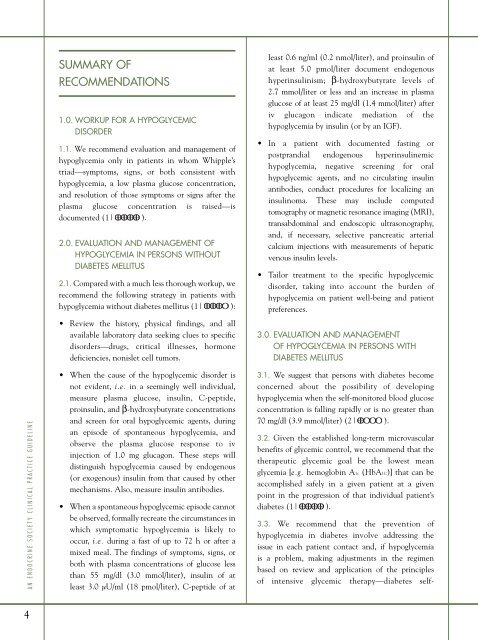Evaluation & Management of Adult Hypoglycemic Disorders
Evaluation & Management of Adult Hypoglycemic Disorders
Evaluation & Management of Adult Hypoglycemic Disorders
Create successful ePaper yourself
Turn your PDF publications into a flip-book with our unique Google optimized e-Paper software.
AN ENDOCRINE SOCIETY CLINICAL PRACTICE GUIDELINE<br />
4<br />
SUMMARY OF<br />
RECOMMENDATIONS<br />
1.0. WORKUP FOR A HYPOGLYCEMIC<br />
DISORDER<br />
1.1. We recommend evaluation and management <strong>of</strong><br />
hypoglycemia only in patients in whom Whipple’s<br />
triad—symptoms, signs, or both consistent with<br />
hypoglycemia, a low plasma glucose concentration,<br />
and resolution <strong>of</strong> those symptoms or signs after the<br />
plasma glucose concentration is raised—is<br />
documented (1| ).<br />
2.0. EVALUATION AND MANAGEMENT OF<br />
HYPOGLYCEMIA IN PERSONS WITHOUT<br />
DIABETES MELLITUS<br />
2.1. Compared with a much less thorough workup, we<br />
recommend the following strategy in patients with<br />
hypoglycemia without diabetes mellitus (1| ):<br />
• Review the history, physical findings, and all<br />
available laboratory data seeking clues to specific<br />
disorders—drugs, critical illnesses, hormone<br />
deficiencies, nonislet cell tumors.<br />
• When the cause <strong>of</strong> the hypoglycemic disorder is<br />
not evident, i.e. in a seemingly well individual,<br />
measure plasma glucose, insulin, C-peptide,<br />
proinsulin, and β-hydroxybutyrate concentrations<br />
and screen for oral hypoglycemic agents, during<br />
an episode <strong>of</strong> spontaneous hypoglycemia, and<br />
observe the plasma glucose response to iv<br />
injection <strong>of</strong> 1.0 mg glucagon. These steps will<br />
distinguish hypoglycemia caused by endogenous<br />
(or exogenous) insulin from that caused by other<br />
mechanisms. Also, measure insulin antibodies.<br />
• When a spontaneous hypoglycemic episode cannot<br />
be observed, formally recreate the circumstances in<br />
which symptomatic hypoglycemia is likely to<br />
occur, i.e. during a fast <strong>of</strong> up to 72 h or after a<br />
mixed meal. The findings <strong>of</strong> symptoms, signs, or<br />
both with plasma concentrations <strong>of</strong> glucose less<br />
than 55 mg/dl (3.0 mmol/liter), insulin <strong>of</strong> at<br />
least 3.0 µU/ml (18 pmol/liter), C-peptide <strong>of</strong> at<br />
least 0.6 ng/ml (0.2 nmol/liter), and proinsulin <strong>of</strong><br />
at least 5.0 pmol/liter document endogenous<br />
hyperinsulinism; β-hydroxybutyrate levels <strong>of</strong><br />
2.7 mmol/liter or less and an increase in plasma<br />
glucose <strong>of</strong> at least 25 mg/dl (1.4 mmol/liter) after<br />
iv glucagon indicate mediation <strong>of</strong> the<br />
hypoglycemia by insulin (or by an IGF).<br />
• In a patient with documented fasting or<br />
postprandial endogenous hyperinsulinemic<br />
hypoglycemia, negative screening for oral<br />
hypoglycemic agents, and no circulating insulin<br />
antibodies, conduct procedures for localizing an<br />
insulinoma. These may include computed<br />
tomography or magnetic resonance imaging (MRI),<br />
transabdominal and endoscopic ultrasonography,<br />
and, if necessary, selective pancreatic arterial<br />
calcium injections with measurements <strong>of</strong> hepatic<br />
venous insulin levels.<br />
• Tailor treatment to the specific hypoglycemic<br />
disorder, taking into account the burden <strong>of</strong><br />
hypoglycemia on patient well-being and patient<br />
preferences.<br />
3.0. EVALUATION AND MANAGEMENT<br />
OF HYPOGLYCEMIA IN PERSONS WITH<br />
DIABETES MELLITUS<br />
3.1. We suggest that persons with diabetes become<br />
concerned about the possibility <strong>of</strong> developing<br />
hypoglycemia when the self-monitored blood glucose<br />
concentration is falling rapidly or is no greater than<br />
70 mg/dl (3.9 mmol/liter) (2| ).<br />
3.2. Given the established long-term microvascular<br />
benefits <strong>of</strong> glycemic control, we recommend that the<br />
therapeutic glycemic goal be the lowest mean<br />
glycemia [e.g. hemoglobin A1c (HbA1C)] that can be<br />
accomplished safely in a given patient at a given<br />
point in the progression <strong>of</strong> that individual patient’s<br />
diabetes (1| ).<br />
3.3. We recommend that the prevention <strong>of</strong><br />
hypoglycemia in diabetes involve addressing the<br />
issue in each patient contact and, if hypoglycemia<br />
is a problem, making adjustments in the regimen<br />
based on review and application <strong>of</strong> the principles<br />
<strong>of</strong> intensive glycemic therapy—diabetes self-


